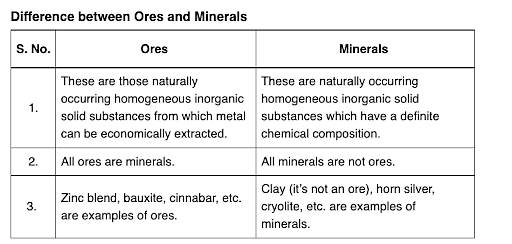Match items of Column I with the items of Column II and assign the correct code:


- (a) $\to$ (ii) ,(b) $\to$ (iii) ,(c) $\to$ (i) ,(d) $\to$ (v)
- (a) $\to$ (i) ,(b) $\to$ (ii) ,(c) $\to$ (iii) ,(d) $\to$ (iv)
- (a) $\to$ (iii) ,(b) $\to$ (iv) ,(c) $\to$ (v) ,(d) $\to$ (i)
- (a) $\to$ (iv) ,(b) $\to$ (ii) ,(c) $\to$ (iii) ,(d) $\to$ (i)
The Correct Option is D
Approach Solution - 1
Extraction Processes
Cyanide Process:
The cyanide process is used to extract gold (Au) from its ores. The process involves the following reactions:
\(4Au + 8NaCN + O_2 + 2H_2O \to 4Na[Au(CN)_2] + 4NaOH\)
After this, the impure gold cyanide complex is treated with zinc to reduce the gold:
\(2Na[Au(CN)_2] \xrightarrow{[Zn]} \underset{\text{ppt}}{2 Au} + Na_2[Zn(CN)_4]\)
Froth Floatation Process:
The froth flotation process is used for concentrating sulphide ores. This method involves using air bubbles to separate the desired minerals from the rest of the ore by creating froth, where the mineral particles attach to the bubbles.
Electrolytic Reduction (Hall-Heroult Process):
The Hall-Heroult process is used to extract aluminium from its ore, bauxite. This process involves the electrolytic reduction of bauxite in the presence of cryolite:
Electrolytic reduction of bauxite is done by dissolving the ore in molten cryolite (Na₃AlF₆) and applying a direct current. This reduces aluminium oxide to aluminium metal at the cathode.
Zone Refining:
Zone refining is a method of purifying semiconductor materials like Germanium (Ge) and Silicon (Si). In this method, a molten zone is passed along the material, selectively dissolving impurities into the molten region, which is then moved to the next region for further purification.
Approach Solution -2
- Cyanide process: This process is used for the extraction of gold (Au), hence it is matched with (iv) Extraction of Au.
- Froth flotation process: This is used for concentrating sulphide ores like ZnS (zinc sulfide), so it is matched with (ii) Dressing of ZnS.
- Electrolytic reduction: This is the method used to extract aluminum (Al) from bauxite, so it is matched with (iii) Extraction of Al.
- Zone refining: This technique is used for purifying materials like germanium (Ge), so it is matched with (i) Ultrapure Ge.
Correct Code:
(a) → (iv), (b) → (ii), (c) → (iii), (d) → (i)
Top Questions on General Principles and Processes of Isolation of Elements
- In the extraction of iron using blast furnace to remove the impurity (X), chemical (Y) is added to the ore. X and Y are respectively
- TS EAMCET - 2025
- Chemistry
- General Principles and Processes of Isolation of Elements
- What is used for the Thermite Reaction?
- BCECE - 2025
- Chemistry
- General Principles and Processes of Isolation of Elements
- Which of the following compounds is used to cover the surface of a metallic object to prevent corrosion?
- KEAM - 2025
- Chemistry
- General Principles and Processes of Isolation of Elements
- On reaction of Lead Sulphide with dilute nitric acid which of the following is not formed ?
- JEE Main - 2024
- Chemistry
- General Principles and Processes of Isolation of Elements
- Electrometallurgical process is used for the extraction of which of the following metals?
- Bihar Board XII - 2024
- Chemistry
- General Principles and Processes of Isolation of Elements
Questions Asked in NEET exam
- With the help of the given pedigree, find out the probability for the birth of a child having no disease and being a carrier (has the disease mutation in one allele of the gene) in the F3 generation.

- NEET (UG) - 2025
- Genetics
- The plates of a parallel plate capacitor are separated by d. Two slabs of different dielectric constant \(K_1\) and \(K_2\) with thickness \(d/2\) and \(d/2\) respectively are inserted in the capacitor. Due to this, the capacitance becomes two times larger than when there is nothing between the plates. If \(K_1 = 1.25 K_2\), the value of \(K_2\) is :
- NEET (UG) - 2025
- Capacitors and Capacitance
- The correct order of the wavelength of light absorbed by the following complexes is:
A. $[ \text{Co(NH}_3\text{)}_6]^{3+}$
B. $[ \text{Co(CN)}_6]^{3-}$
C. $[ \text{Cu(H}_2\text{O)}_4]^{2+}$
D. $[ \text{Ti(H}_2\text{O)}_6]^{3+}$
Choose the correct answer from the options given below:- NEET (UG) - 2025
- Coordination chemistry
- Consider the diameter of a spherical object being measured with the help of a Vernier Callipers. Suppose its 10 Vernier Scale Divisions (V.S.D.) are equal to its 9 Main Scale Divisions (M.S.D.). The least count in the M.S. is 0.1 cm and the zero of V.S. is at -0.1 cm when the jaws of Vernier callipers are closed. If the main scale reading for the diameter is \(M = 5\) cm and the number of coinciding vernier division is 8, the measured diameter after zero error correction, is:
- NEET (UG) - 2025
- Measurement of length
- In some appropriate units, time (t) and position (x) relation of a moving particle is given by \(t = \alpha x^2 + \beta x\). The acceleration of the particle is :
- NEET (UG) - 2025
- Kinematic equations for uniformly accelerated motion
Concepts Used:
General Principles and Processes of Isolation of Elements
What are Ores and Minerals?
Minerals are the naturally occurring, homogeneous inorganic solid substances. They are having a definite chemical composition and crystalline structure, hardness and color. For example, copper pyrite, calamine, etc.

Impurities in an ore are called gauge. The removal of a gauge from the ore is called concentration ore.
Several steps are involved in the extraction of pure metal from ores. Major steps are as follows –
- Concentration of the ore
- Isolation of the metal from its concentrated ore
- Purification of the metal